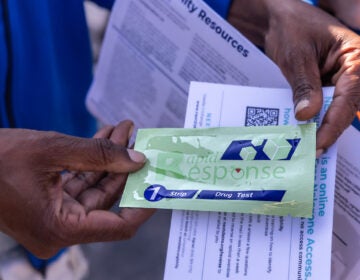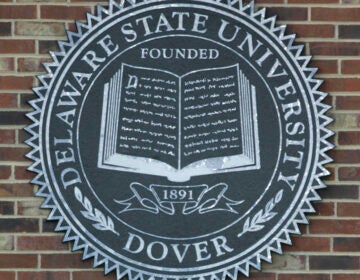Delaware state board tackles big education issues in December meeting
 via ShutterStock. " title="school-169-2" width="1" height="1"/>
via ShutterStock. " title="school-169-2" width="1" height="1"/>
The December meeting of Delaware’s State Board of Education lasted more than six hours and touched on some of the First State’s hottest education debates.
Charter schools, accountability, school expansion, testing, redistricting–all of it surfaced at the marathon Thursday meeting.
Here’s a quick primer on one of the busiest state board meetings in recent memory.
Delaware makes an unprecedented charter decision
The Delaware Met, a charter high school in Wilmington, opened this August. Less than half a year later, it will close. The state board decided Thursday to revoke the school’s charter due to financial distress, poor curricular standards, and school safety concerns. The state has never closed a charter so soon after its opening day. The head of Delaware’s charter school office, Jennifer Nagourney, called it “an extraordinary decision in extraordinary circumstances.”
You can read more about the Delaware Met decision here.
In cheerier charter news, the state board renewed charters for three schools: Campus Community School, MOT Charter, and Providence Creek Academy.
Report cards are in for Delaware schools
Delaware recently approved a new framework for evaluating its public schools. The Delaware School Success Framework (DSSF) replaces Adequate Yearly Progress (AYP), a standard that emerged out of the No Child Left Behind Act. The tangible byproduct of the DSSF is a new batch of school report cards.
Delaware released a “beta” version of those report cards Thursday. The state hopes these report cards are the standard by which parents and the public can evaluate (and compared) public schools. Each school gets a five-star rating on academic achievement, academic growth, graduation preparedness, and college/career preparation. There’s also demographic and survey response date on each school’s page.
The data collected through DSSF will also be used to sort schools into various tiers such as recognition schools (for those that rate well) and priority schools (for those that fare poorly).
And there is some controversy attached to the DSSF.
Delaware decided to use participation rate on the statewide standardized exam as one of the metrics that impacts a school’s academic rating. So, for example, a school where 100 percent of the students take the statewide test would have a leg up on a school where 70 percent participate.
This provision rankled many, including the citizens working group who helped develop DSSF. Some saw it as a way to discourage parents from opting their children out of standardized tests. Other said it unfairly punished schools for a metric beyond their control.
State officials, however, said the inclusion of participation rate would prevent schools from purposefully not testing low performing students in an attempt to goose their scores.
A new role for the SAT?
For months now, there has been chatter that Delaware might replace its current statewide standardized test for 11th graders with the SAT. That chatter is picking up steam. At Thursday’s meeting, Penny Schwinn, Delaware’s Chief Accountability and Performance Officer, said “it is the intention of the Department to actively pursue using the SAT as the 11th grade accountability assessment.”
“The target time line would be as soon as possible,” said Schwinn. “We’re working as if it could be this spring.”
Translation: In a few short months, Delaware 11th graders might be taking the SAT as their formal accountability test. And schools might be judged on how their students perform on the SAT.
For the moment, schools are judged on how they’re 11th graders do on a test known as Smarter Balanced. There are a number of reasons why Delaware might makes this change.
Eleventh graders take a lot of tests. Many sit for the SAT, the ACT, and AP exams. That’s in addition to taking Smarter Balanced. Using the SAT as an accountability exam would take one test off the 11th-grade docket. A student could take the SAT for college-entrance purposes and accountability purposes instead of taking two separate tests.
Lots of eleventh graders don’t take Smarter Balanced seriously. This is probably best borne out by the fact that the test participation rate for Smarter Balanced is significantly lower in 11th grade than it is at any other grade level (3-8 graders also take a version of the test). The reason is simple: students have no incentive to do well on Smarter Balanced. Even though schools are judged by how their students fare, there are no individual consequences (or rewards) for the students themselves. College-bound students, however, have an obvious incentive to do well on the SAT–it helps them get into college.
Delaware already gives the SAT to every 11th grader. It’s a state policy. So there wouldn’t be too much wrangling involved
The SAT is changing. In 2016, College Board will roll out a new version of the test that is aligned to Common Core standards. Those are the same standards Delaware adopted in 2010 and the same standards Smarter Balanced is designed to gauge.
Schwinn told the state board that five other states are making the change to SAT as their official accountability test for 11th graders. It looks as though Delaware will join them, sooner or later.
Redistricting chatter grows louder
On Tuesday, the Wilmington Education Improvement Commission (WEIC) approved a redistricting plan that would move roughly 2,500 Wilmington students from the Christina School District to the Red Clay Consolidated School District. On Thursday, the WEIC formally presented that plan to the State Board of Education.
This was just a presentation–not a vote. The State Board will either approve or reject the plan at its January meeting.
But the presentation was revealing.
State board members asked repeatedly how much the redistricting plan might cost–and who might pay for it. The response? WEIC members the three-year transition plan would require about $7.5 million in recurrent funding. But that was presented as an estimate.
As for the source of that funding, WEIC chair Tony Allen said his group was “in negotiations” with Governor Jack Markell about securing state funds to cover transition costs. The WEIC also wants state legislators to approve a weighted funding formula that would attach more money to low-income students and English Language Learners.
Those answers didn’t appear to mollify state board members.
“The 800 pound gorilla in the room is how much is it gonna cost,” said board member Gregory Coverdale.
Added fellow board member Patrick Heffernan, “We don’t know what we’re signing up for.”
Next month, the state board will decide whether or not to approve the first major redistricting plan in Wilmington since the early 1980s. If they give it the OK, the plan will then have to then earn the support of the General Assembly and the Governor.
Where the schools are
Back in March, Governor Markell asked the state board for a formal review of specialized education opportunities available in Delaware. The Strategic Review of Educational Opportunities would map out every single school program in every single public school–and include supply/demand data to determine where there were gluts and where there were needs.
The state paid about $70,000 to Public Consulting Group (PCG) to perform that analysis. PCG presented their findings Thursday to the state board.
The 65-page report contains some interesting insights. African American students, for instance, are proportionally more likely to choice into a school than white students. And there’s a nifty, interactive map where folks can browse for different types of programs.
But the report wasn’t able to answer detailed questions about supply and demand. That’s in part, PCG said, because Delaware schools don’t keep detailed waitlist data.
Now that the initial report is out, the Delaware Department of Education will develop a strategic plan around school growth in Delaware. That plan could be done as soon as the end of the school year.
That plan is critical for a number of reasons. First, it should set the course for school and program and expansion in Delaware. Also, it could be key to lifting the moratorium on new charter schools in Wilmington.
Earlier this year, the General Assembly passed a law prohibiting the state from opening new charter schools in Wilmington until June 30, 2018 or until “the State Board of Education develops a strategic plan for the number of charter, district, and vocational-technical schools in the State.” In other words, if the state crafts a new plan it would likely lift the cap and re-open Wilmington’s charter sector.
WHYY is your source for fact-based, in-depth journalism and information. As a nonprofit organization, we rely on financial support from readers like you. Please give today.





